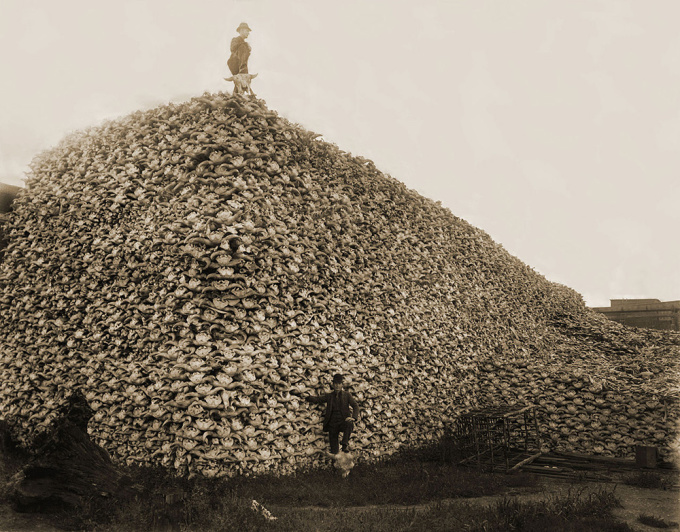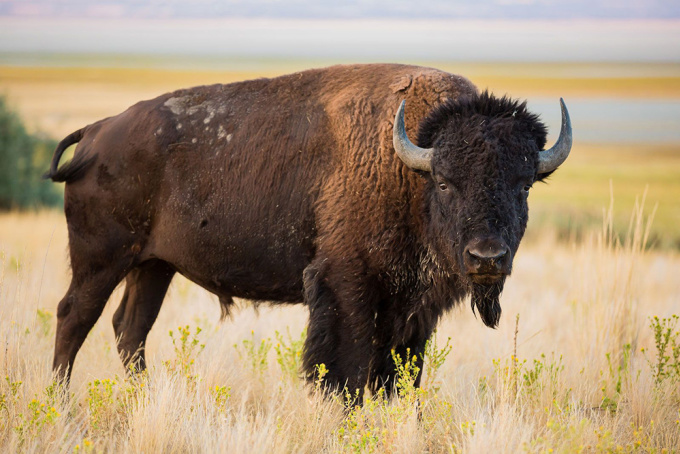In just the last 20 years of the 19th century, the number of bison in the southern plains of North America fell from 10 million to 500.

A mountain of American bison skulls waiting to be ground into fertilizer in 1892. Photo: Wikimedia
When North American bison were decimated in the late 19th century, the Native Americans who relied on them suffered severe consequences. Research published in The Review of Economic Studies on May 24 found that not only did this group of natives lose significant height, but they also experienced increased child mortality, a change in their quality of life that persists to this day.
The American bison ( Bison bison ) is a herbivore distributed mainly in North America. In the wild, the average lifespan of this animal is 12 - 20 years. They weigh an average of 420 - 1,000 kg, and are 2 - 3.5 m long, not including the tail. They have curved and sharp horns, which can be up to 60 cm long.
Bison were an important resource for Native Americans in the Great Plains, Northwest, and Rocky Mountains. Beyond food, the animals contributed to nearly every aspect of life, from using their hides to make clothing, blankets, and temporary shelters to using their bones to make tools. But by the late 19th century, bison were nearly extinct due to America’s westward expansion.
In 1870, there were at least 10 million bison in the southern plains of North America, but less than 20 years later, the population had dwindled to just 500 wild individuals. The slaughter was largely driven by economics and settlers’ need for land. Initially, American farmers introduced cattle, competing with bison for space. Then, in the 1870s, they were hunted for their hides, which had become easier to tan due to the development of the leather industry.
Bison were also hunted for sport and as roadblocks – railroad workers would kill herds near any tracks to prevent them from impeding train travel. The US military also encouraged the killing of the animals, as the federal government understood that their extermination would help control the Native American population.

American bison ( Bison bison ). Photo: Oliver/Stock.adobe
Before the decline of bison, the indigenous communities that relied on them were among the wealthiest in the Americas. Academic research suggests that their standard of living was on par with, and perhaps even better than, their European contemporaries. But the loss of bison had lasting negative effects on them.
Native American communities faced severe malnutrition and starvation. There is evidence that they resorted to eating horses, mules, dirty food, and even old clothes to avoid starvation. The loss of these resources cost them their livelihoods and stability that had existed for centuries.
According to a study published on May 24 by Donn L. Feir, an associate professor in the Department of Economics at the University of Victoria, and colleagues, communities that relied on bison were 2 to 3 centimeters shorter than other Native American communities that did not rely on the animals. They relied on data collected by physical anthropologist Franz Boas between 1889 and 1903. Boas recorded the height, sex, and age of nearly 9,000 Native Americans.
Scientists have shown that the eradication of bison led to a significantly higher child mortality rate, nearly 16%, in the early 20th century. In addition, the study found that bison-dependent communities experienced a large-scale occupational shift with lasting effects. Since the late 20th century, their per capita income has remained, on average, 25% lower than that of non-bison-dependent communities.
New research shows a reversal in wealth that offers a valuable explanation for the geographic clustering of poverty among Native communities in North America. According to Feir and his colleagues, the study helps experts understand the processes that have led Native American communities in the Great Plains to have some of the lowest incomes in the United States.
Thu Thao (According to IFL Science )
Source link


































































































Comment (0)